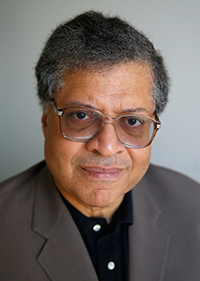December 3rd, 2017 — jazz reviews
Don’t know whether you’ve heard or not, but as of this year, professional basketball has become the Number One Sport in America. Many can, and likely will argue with me on this and we can do so another time. But I know that with this prominence has come some chatter among the philosophically inclined (or challenged) about how basketball is such a prototypically American team game where everybody plays together as a unit while allowing individual brilliance to come forth in dramatic ways while playing within the rules and blah-de-blah-blah…
I mean…I know that ALL team sports allow for that to varying degrees, right? But the basketball cognoscenti contends that it’s the grand, freewheeling and often explosive manner in which players express themselves spontaneously within the confines of the game that solidifies its global appeal. (Once again, blah-de-blah-blah-and again we can fight about this later.)
The only reason I’m bringing it up here is that there was a time — and not all that long ago — when people spoke in this manner about jazz music, another American-born enterprise allowing for, even compelling individual spontaneity within a collective endeavor. Both basketball and jazz have deployed “jam” and even “jam sessions” in their argot, though they technically mean different things. And, as is especially the case with the pro game, basketball depends heavily on stars drawing fans’ wayward attention spans into the not-always-conspicuous-but-deeply-satisfying graces within the sport. Jazz likewise searches far and wide for first-magnitude stars and doesn’t lack for hot young “phenoms” of its own. (Number 1 on this list.) It also has ageless wonders who can still “ball” with eye-popping agility (Numbers 2 and 7), slammers who aren’t afraid to go hard and inside (Numbers 4, 5 and 10) and sharpshooters with wide wingspans (Numbers 3, 6, 8, 4 and 1, again).
I just wish I knew the secret to jazz drawing in, at the very least, the savants who care so much about whether the “Dubs” (look it up) repeat again as champs or whether the Celtics-Sixers rivalry is really going back to where it used to be in the 1980s/1960s or whether LeBron James is gunning hard for a third MVP award or whether the Thunder has too many shooters, etc. Why can’t jazz get buzz like that?
Because, as with everything else in the recording industry (whatever the hell THAT is these days), jazz’s future is locked in a chrysalis forged by changes in distribution, marketing and even packaging. (How long and deep is the vinyl resurgence anyway?) And when the chrysalis bursts, then what? Or, more to the point, so what? Jazz isn’t in a position to lead change, but it will, or should adapt to the changes overtaking the American psyche in matters of gender, economics and, as always, race, defined here a mythic construct that nonetheless holds American minds hostage.
(We can table that discussion for another time, too.)
Through it all, the music abides. And, for anybody bothering to listen, it’s stronger, livelier and more vibrant than ever. Case in point:

1.) Cecile McLorin Salvant, Dreams and Daggers (Mack Avenue) – As of this album, her third (or maybe fourth), it is no longer enough to say she’s the most talented young vocalist to appear in decades. Nor is enough to say that she’s the best jazz singer of her (Millennial) generation. This double disc package, composed mostly of sets gathered from a September, 2016 Village Vanguard engagement, proclaims Cecile McLorin Salvant as a star of such near-blinding magnitude that if I could have given the first five spots on the list to this album, I would. Put another way (and I apologize if I’m repeating myself): I cannot remember ever hearing a singer achieving before the age of 30 such a formidable command of rhythm, tone, nuance, articulation and idiom. Prodigies before her have come and, often, gone with her abundance of resources. But among many other things, she can bend, without undue distortions, any phrase in any standard, allowing the familiar lyrics in such chestnuts as “You’re My Thrill,” “The Best Thing For You”(with its challenging chord and line shifts), “I Didn’t Know What Time It Was” and “Let’s Face the Music and Dance” to lope around, lag behind and leap ahead of their assigned tempos with a veteran’s imperturbable authority. As she has in her previous albums, she pounds hard-core blues tunes such as “Sam Jones’ Blues” and “You Got To Give Me Some” as if born and bred in brawling roadhouses. But she treats the words of these raw-boned songs with same solicitude and care that she applies to the suave cheekiness of Bob Dorough’s “Nothing Like You” and “Devil May Care” or to the ruminative pathos of the Jule Styne-Bob Merrill plaint, “If a Girl Isn’t Pretty.” She is a skilled dramatist, probing and engaging the character behind each song – though I wish another dramatist would someday fashion a vehicle that could showcase her brilliance on stage or screen the way Funny Girl delivered Barbra Streisand to the center of the universe. She’s also playful, but she aint playing. Nor is she a dilettante wandering aimlessly, from show tunes to primordial funk and back to her own original musings (“More,” “Red Instead.”) She’s probing for connections, linkages, overlapping characteristics of each tune with the kind of fortitude that over time could reinforce the foundations of American music for new generations of players, poets and lovers. And, as I may or may not have mentioned earlier, she’s only 28 years old. I did neglect to mention the comparably dynamic support of her rhythm section, especially pianist Aaron Diehl, who’s becoming a first-magnitude star on his own. I can’t tell you any more. There are some things you’re going to have to see and hear for your own selves.

2.) Ahmad Jamal, Marseille (Jazzbook/Jazz Village)—Meanwhile, at the opposite end of the age spectrum, Ahmad Jamal is 87 years old, which means he’s three years away from being a nonagenarian. Paradoxically, he has in recent years sounded younger with age; more energetic and adventurous than he did back in the 1950s when he was wowing Chicago’s Pershing nightclub with his variations on “Poinciana.” His late-winter resurgence continues on this session with drummer Herlin Riley, bassist James Cammack and percussionist Manolo Badrena. His cleverness, whose flamboyance at one time annoyed the purists, has acquired keener, rougher edges on such tunes as “Sometimes I Feel Like a Motherless Child” and “Autumn Leaves,” the latter of which is a clinic on how a pianist and a rhythm session contain and release tension like dancers working within a narrow space. His timing and poise as leader and soloist have likewise sharpened, especially on his original compositions, “Pots En Verre,” “Baalbeck” and the title tune, given three variations here; first as a straight-ahead instrumental, then with a spoken version (by Abd Al Malik) and a ballad rendering (Mina Agossi) of Jamal’s French-language lyrics – which, by the way, are also pretty deft for a man of his advanced years. But who’s counting anyway? I’m going to predict that, by his 90th birthday in 2020, he’ll still be playing keep-away games with space and time on his piano and keeping his bass-drum tandems on their toes. Anybody want to bet against me? Or him?
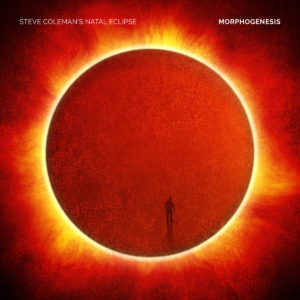
3.) Steve Coleman’s Natal Eclipse, Morphogenesis (PI) – I’m resisting the temptation to label what Coleman’s been doing these last few years as an ongoing biological experiment. That would make it sound clinical and the music he and his various ensembles have recorded is anything but. Functional Arrythmias (2013) dealt with cardiovascular matters while Synovial Joints (2015) dared you to imagine knees, elbows, shoulders and legs accommodating themselves to whatever the music, organically conceived and arranged into being, was willing them to do. This time, the shape-shifting dynamics of Coleman’s approach is geared towards movement, core, tactics, kinesis and thrust; in other words, martial arts, specifically boxing. (You heard.) Thus the orchestrations have more density and drive, which makes this album at once more inscrutable and more accessible than its immediate predecessors. Jonathan Finlayson’s trumpet shows greater range of expression even when flying in close formation with Coleman’s alto saxophone. Jen Shyu’s voice returns to the mix while pianist Matt Mitchell, drummer Greg Chudzik, tenor saxophonist Maria Grand, violinist Kristin Lee and percussionist Neeraj Mehta all work together to create an collective entity of sound and rhythm you could use to prepare for any bout you have on the schedule, metaphorical or otherwise. Since these releases seem timed for every two years, I’m guessing Coleman and crew have another inquiry due in 2019. Is it possible, doctor, that…the human brain could be next on his agenda? (Egad!)
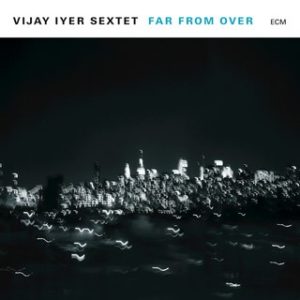
4.) Vijay Iyer Sextet, Far From Over (ECM) – “Down to the Wire,” “Into Action,” “Wake,” “End of the Tunnel”…The titles alone are challenges hurled into the Whirlwind of Now, especially the title track, which pulses throughout like a urgent telegraph message seeking a way out of the whatever it is we’ve been going through for (at least) the last year. Iyer, having done everything with the piano trio short of equipping it with double jet packs and a hood ornament, takes the wheel of this super-powered ensemble and comes perilously close to redefining the horns-rhythm-section paradigm. Pianist Iyer, bassist Stephan Crump and drummer Tyshawn Sorey lay down a sweet, spongy groove for “Nope” that gives the front line of alto saxophonist Steve Lehman, tenor saxophonist Mark Shim and horn master Graham Haynes lots of room to leap with controlled abandon. Electronics are deployed with discretion and purpose on the aforementioned “End of the Tunnel” while “Down to the Wire’s” overlapping riffs and steel-mesh polyrhythms exemplify the band’s breakneck intensity as does the lyrical fire shooting out of that elite horn section. Even when in relative reflection (“For Amiri Baraka”), the album seethes and goads its listeners to lean in and press forward into whatever trials lay ahead. We should probably take a hint from the way these guys go all out on these tracks: That our only way out of this mess may be us.
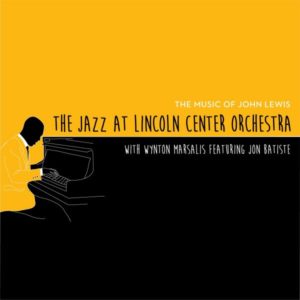
5.) Jazz at Lincoln Center Orchestra with Wynton Marsalis, The Music of John Lewis (Blue Engine) — Wynton Marsalis wasn’t the first musician to merge classical aspirations with jazz performance. Neither was John Lewis. But Lewis (1920-2001), who led the epochal Modern Jazz Quartet for roughly half his life, helped define by the middle of the last century a useable tradition within jazz music that could draw extensively upon its own heritage (blues, bop, swing and such) while establishing communion with baroque, romantic, impressionist and other genres linked to Europe. This legacy is vast and enduring enough to affect most of the jazz music written today, including most, if not all of the music represented on this list. Marsalis, especially, knows how much the very notion of Jazz at Lincoln Center, and jazz repertory in general, owes to Lewis and this tribute, recorded four years ago at Rose Hall, is an institution’s deeply-felt and elegantly-framed expression of gratitude. Marsalis, as ever, is the emcee-impresario as well an occasional soloist. But at center stage for this show is pianist Jon Batiste, a couple years before becoming nationally known as Steven Colbert’s “Late Show” bandleader-collaborator-egger-on. He proves an insightful surrogate for Lewis’ own inventions on such timeless pieces as “2 Degrees West, 3 Degrees East,” “Two Bass Hit” and (of course) “Django.” The concert’s revelations come in the orchestra’s renditions of themes taken from MJQ’s 1962 masterwork, The Comedy. That suite sustained the most knocks at the time from jazz peeps who believed Lewis was bowing too low to the European masters. But the orchestra, using a score adapted for big band by David Berger, makes the whole apparatus swing hard without in any way mitigating its surging romanticism. If I may partake of a quibble: The lovely “La Cantatrice” is rendered in these settings without a vocal proxy for the young Diahann Carroll, who sang this aria with the quartet on the Atlantic album. If the LCJO repeats this segment of the MJQ experiment, I know just the singer for the job. (Again, see Number 1 on this list).

6.) Matt Wilson, Honey and Salt: Music Inspired by the Poetry of Carl Sandburg (Palmetto) – Coming across this homage to the First Jazz Poet is like wandering into a neglected corner of one’s attic and stumbling into these motley contraptions that, with a little oil in their wheels and cleaning fluid in their cogs, can still whirr, hum and beguile. Drummer-bandleader-composer Wilson comes by his devotion legitimately, having hailed from the same Knox County, Illinois birthplace as Sandburg and been distantly related to boot. He’s been touring with his Carl Sandburg project for a few years now and has now yielded a cozy, colorful quilt of Sandburg-related instrumentals, songs and readings that constitute one of the precious few times that a jazz-poetry synthesis has worked so well. (Hell, worked. Period.) With Ron Miles on trumpet, Jeff Lederer on reeds, Martin Wind on bass and Dawn Thomson on guitar and lead vocals, Wilson provides deceptively simple frameworks, rhythmically and otherwise, for a Sandburg cornucopia (never has the word seemed more appropriate): A loping shuffle for “Soup”; an indigo-blue slow jam for “Night Stuff” (with Miles in top form) and a moody prairie lament for “Bringers” (“…of dawn and dusk and dreams…”). Even more intriguing is the interplay of the music with the poems as read by such notables as Jack Black (“Snatch of Slipshod Jazz”), Carla Bley (“To Know Silence Perfectly”), Rufus Reid (“Trafficker”), John Scofield (“We Must Be Polite”) and Sandburg himself, whose recital of “Fog,” where most of us first learned about metaphor in grade school, is stretched and elaborated upon by Wilson’s trap set. Is it possible for a jazz album to restore a literary reputation? I can’t say, but I do know when I hear the group join their voices on Sandburg’s “Choose” – “The single clenched fist lifted and ready/Or the open asking hand held out and waiting/Choose/For we meet by one or the other” – it feels very much as though these poems, their author and this project have arrived in our midst exactly when we need them most.
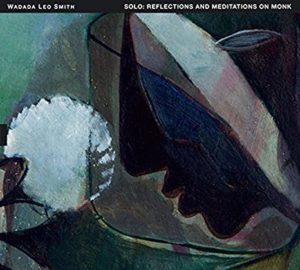
7.) Wadada Leo Smith, Solo: Reflections & Meditations on Monk (TUM) I’ll repeat here what I said two months ago: At age 75, Smith is enjoying a bountiful winter of recognition for his life’s work as trumpeter, composer and bandleader, creating fresh contexts for orchestrated jazz and delivering plaintive, ruminative yet remarkably agile narratives on his horn. His liner notes acknowledge his considerable debt to Monk, “an inspiration that arcs straight across the structured invisible world.” Smith’s own art, whether alone or in groups, uses intervals as nimbly as the master. In his own renditions of “Ruby, My Dear,” “Reflections,” “Crepuscule with Nellie” and “Round Midnight” (all of which dare the bold and the thoughtful to bring their “A” Game), Smith seems to know precisely how to sustain spaces between phrases and, more important, when to come in hard, when to use stealth – and, in the case with “Nellie,” when to let its essential form do most of the work. He rounds out the album with original pieces, a couple of them stimulated by visual depictions of the pianist at work (“Monk and his Five-Point Ring at the Five Spot Café,” “Adagio Monk, the Composer in Sepia – A Second Vision”) and another, intriguingly speculative narrative (“Monk and Bud Powell at Shea Stadium – A Mystery”). Generations of jazz musicians have brought their adorations of Monk to his legacy’s front door. I doubt there is any other musician alive who could have presented anything as austere, adventurous and challenging as Smith’s recital.

8.) Miguel Zenon, Tipico (Miel Music) – The title of the first track, “Academia” sounds vaguely like a threat, especially since it was apparently inspired by Zenon’s interaction with his students at the New England Conservatory of Music. But it’s a buoyant, effervescent take, setting you up for similarly joyful interactions to come. Zenon has in the past organized his albums around specific themes and narratives connected to his Puerto Rican heritage. But this time, he intends nothing more than a celebration of his 15-year affiliation with the rest of his quartet (pianist Luis Perdomo, bassist Hans Glawisching and drummer Henry Cole). What results is hardly academic, but you could learn a lot from the way Zenon’s alto sax communicates with the other instrumentalists. On “Cantor,” for instance, Glawisching and Perdomo lay down a spectral path for Zenon to soar, hover and gradually to create spiraling patterns whose intricacies sneak up on you. The title track evokes a whole subcontinent of rhythmic and melodic influences, galvanized by the quartet’s collective sway and swagger. Zenon’s intelligence and authority are asserted as definitively as on his previous albums. But this time, there’s a relaxed open-heartedness shared by all the musicians, whose only imperative is to make it all move at different tempos (tempi?) in beauty and mystery. Zenon’s playing, at least to these ears, has never sounded as frisky or as limpid as it does here.
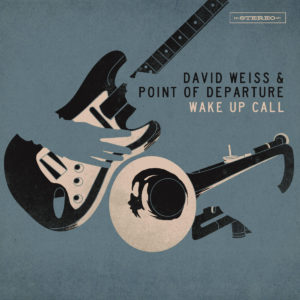
9.) David Weiss & Point of Departure, Wake Up Call (Ropeadope) – Weiss, as he’s proven with all his varied ensembles (including this one), knows his way around the repertoire of the 1960s. He also is unapologetically drawn to the possibilities opened up by jazz-fusion of the 1970s and he’s apparently determined to help finish, or resolve, what those fusion artists started. The Point of Departure outfit is heard here in the kind of transition that jazz itself was a half-century ago as electronics seeped into hard bop’s domain. Only the album’s midsection, “Unfinished Business,” retains tenor saxophonist J.D. Allen and guitarist Nir Felder from the ensemble’s previous incarnation. For the rest, trumpeter-leader Weiss ups the ante by using two guitarists: Travis Reuter and Ben Eunson while Myron Walden assumes the tenor sax chair. The combination jars at first, but only for a while. And the ensemble shows its tight-knit cohesion when it dives into amplified renderings of John McLaughlin’s “Sanctuary,” Joe Henderson’s “Gazelle” and Tony Williams’ “Pee Wee.” On “The Mystic Knights of The Sea,” drawn from Williams’ early 70s band, Lifetime, Weiss’ group shows that piece to be not too far removed conceptually from the Williams who played with Miles Davis’ legendary mid-60s quintet. Everybody involved is focused and engaged, but if this album has an emerging star, it’s drummer Kush Abadey, who powers this edition of “POD” with a ferocity that seems ballistic in execution. He must be destined for greater things because Han Solo, who knows a little something about hyper-drive, made what’s known as the “jazz face” when he saw Abedey flash leather not so long ago at Small’s jazz club. He wouldn’t be the first star Weiss helped propel into greater prominence. And he won’t be the last.
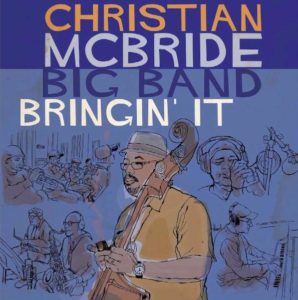
10.) Christian McBride Big Band, Bringin’ It (Mack Avenue) – I’ve always suspected that there have been two identities in pitched battle for bassist McBride’s Philly-forged soul, one side embodied by Ray Brown, the other by Bootsy Collins. In this setting, and likely in others yet to come, the two sides aren’t in conflict so much as in spirited negotiations for a workable, lasting truce. The first track, a backyard-party rouser titled “Gettin’ To It,” loosens your bow tie and gives your head a reason to do its version of the Madison, or maybe the Funky Chicken. The immediate follow-up, Freddie Hubbard’s “Thermo,” is a steady-rolling swinger that has little in common with the opener besides the airtight rhythm section (McBride, pianist Xavier Davis, drummer Quincy Phillips and guitarist Rodney Jones) along with fleet-footed soloing by trumpeter Freddie Hendrix and tenor saxophonist Ron Blake. McBride’s wide-screen arrangement of “I Thought About You” discloses his higher-ground ambitions for his large ensemble and the band, with trumpeter Brandon Lee’s solo leading the way, comes through impressively enough for you to hope McBride aims even higher. Talks will likely continue between the Brown and Bootsy sides and McBride is a wicked-smart mediator, though part of me wishes he’d let his Famous Flames side cut loose for just one more album. If it happens, I’m all for him. If it doesn’t, I still am.

HONORABLE MENTION: Craig Taborn, Daylight Ghosts, (ECM) Tyshawn Sorey, Verisimilitude (PI); Heads of State, Four in One (Smoke Sessions); Matthew Shipp Trio, Piano Song (Thirsty Ear); Fred Hersch, Open Book (Palmetto); Jane Ira Bloom, Wild Lines: Improvising Emily Dickinson (Outline); Ron Miles, I Am A Man (Yellowbird); Joey Alexander, Monk. Live. Trio! (Motema); Jazz at Lincoln Center Orchestra with Wynton Marsalis, Handful of Keys (Blue Engine)
BEST REISSUE/ARCHIVAL
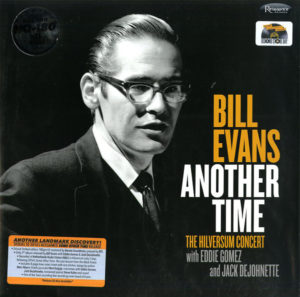
1.) Thelonious Monk, Les Liasons Dangereuses 1960 (SAM)
2.) Bill Evans, Another Time: The Hilversum Concert with Eddie Gomez & Jack DeJohnette (Resonance)
3.) Ornette Coleman, Ornette at 12 & Crisis (Real Gone)
BEST DEBUT ALBUM

Jaimie Branch, Fly or Die (International Anthem LLC)
BEST LATIN ALBUM
Miguel Zenon, Tipico
HONORABLE MENTION: Baptiste Trotignon & Yosvany Terry, Ancestral Memories (Okeh)
BEST VOCAL
Cecile McLorin Salvant, Dreams and Daggers
HONORABLE MENTION: Dominique Eade & Ran Blake, Town and Country (Sunnyside); Sarah Partridge, Bright Lights & Promises: Redefining Janis Ian (Origin)
December 4th, 2014 — jazz reviews
A strange year, an exasperating year; maybe even an ominous one for jazz music’s already diminished stature in the marketplace. First this happened, followed closely by this. And then this came up and so did all the resulting cawing and cackling on the social media sites. When you add the very public, free-falling disgrace of the nation’s leading — or, at the very least, most famous — jazz devotee, you may as well shrink wrap and label 2014 as a bummer despite the varied finery listed below.
And I know what you saner, stoic ones are going to say: That a list such as mine, or anyone else’s, represents the best possible counterargument to the signifying-nothing that is sound-and-fury, on- or offline. Art doesn’t care what the Washington Post or New Yorker says or does – or mostly doesn’t. Art walks its own serene path through the fire towards high ground. Art is a ninja-warrior aristocrat with two layers of body armor and an unrelenting poker face. Art would assure me, in firm, modulated timbres, that just because some people think jazz stopped being cool doesn’t mean it has.
Knowing all that, however, doesn’t improve my end-of-the-year mood; one that can’t be quantified as good or bad, but is, all at once, restless, melancholy, somewhat manic and predominantly wary. All told, I’m just a little anxious to see what’s coming next – in jazz and everywhere else.
You ask: Dread or hope? I say: Turtles are cool.
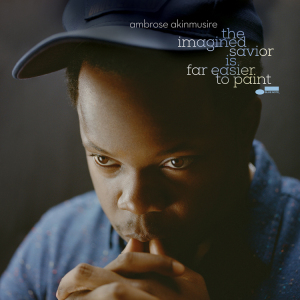
1.) Ambrose Akinmusire, “The Imagined Savior is Far Easier To Paint” (Blue Note) – As with its illustrious Blue Note predecessors from fifty years ago, Akinmusire’s second effort for the label meshes with the subconscious fabric of its turbulent times without needing to be explicit in its content (except when it chooses to do so). Just as Donald Byrd’s “A New Perspective,” which brought this into the world, is still redolent of all that America was going through in the early sixties, so do the somber, mostly minor-key soundscapes in “The Imagined Savior…” reflect present-day sorrow, regret and barely-contained anger with thwarted possibilities. The anger breaks into full, unfettered view in the sepulchral “Rollcall for Those Absent” on which the voice of young Muna Blake, backed only by Akinmusire’s keyboard and Sam Harris’ Mellotron is heard reading the names of young black men shot to death by police, including Amadou Diallo and Trayvon Martin, whose names are intoned more than once. That more names could have been added to this roll since it was recorded only enhances the disc’s up-to-the-minute capital. Adding to this Tapestry of Now is “Our Basement (ed)”, written and sung by Becca Stevens, which is told from the perspective of a homeless man. What counters the ruminative gloom and anxiety of these and other pieces is the vigorous musicianship displayed by Akinmusire as both trumpeter and bandleader. In both capacities, he has a fluid command of phrase that comes across the way electricity would if you could hold it in your hands. Whether letting fly with his regular combo, including front-line partner Walter Smith on tenor sax, or blending with a string quartet, Akinmusire’s horn reaches for and often achieves attributes of the human voice, a quality that clearly marks him as one with all the greats on his instrument who preceded him. If you wonder (as my erstwhile colleague and friend A.O. Scott does) if there are artists who can speak directly and indirectly to the Way We Live Now, look in this corner of the room and get to know its dimensions. Be advised: They can only get bigger from here on.

2.) Allen Lowe, “Mulatto Radio: Field Recordings 1-4 (or: A Jew At Large in the Minstrel Diaspora”)(Constant Sorrow 101) – In the 32-page liner notes accompanying this package, which constitute some of the finest music criticism I’ve read all year, Lowe begins by talking about his “strange encounter” with fellow classicist/bandleader Wynton Marsalis, with whom he dared discuss “the modernist implications of minstrelsy,” which Marsalis pointedly refused to engage since he’s predisposed to regard hip-hop in general and ”Gangsta Rap” in particular as “neo-minstrelsy” catering to racial stereotypes. Which was far from the point that Lowe was attempting to make in the first place. In the six years since that brush-off, Lowe, a polymath who’s as incisive with his shtick as he is with his sax, dove headfirst into what some would consider the mongrelized, or creole-lized foundation of 20th century popular music where shotgun-shack juke joints and free-swinging black vernacular found communion with the tunesmiths piecing together their slick contraptions on Tin Pan Alley, or in the Brill Building. The result of Lowe’s restless search for a proper response to Marsalis is this four-disc omnibus of mostly home-cooked sessions (Lowe lives in Maine) in which several traditions – gutbucket, gospel, early New Orleans, ragtime, bebop, stride, avant-garde, nightclub swing, noir soundtrack, beat poetry and backwoods country – are probed, prodded and often pulled inside out (so to speak) with an eclectic array of musicians from saxophonist J.D. Allen, trumpeter Randy Sandke and clarinetist Ken Peplowski to saxophonist Noel Preminger, pianist Matthew Shipp and singer Dean Bowman. Along with other reeds, horns and rhythm players, there’s also a tuba (Christopher Meeder), a fellow musicologist (Lewis Porter) who plays wicked piano, alone or accompanied, and – of course, what else? – a novelist (Rick Moody). Even some of the titles of these pieces – “Jim Crow Variations”, “The Discreet Charm of the Underclass,” “When My Alarm Clock Rings on Central Park West” (Lowe’s variation of “When it’s Sleepy Time Down South”) – are provocative, mischievous throw-downs to whatever passes these days for dialogue about jazz. And after a year such as this, the prevailing conversation can use some spritzing and shaking-up. (Don’t try to get this through Amazon or I-Tunes. You’re better off ordering it this way.)
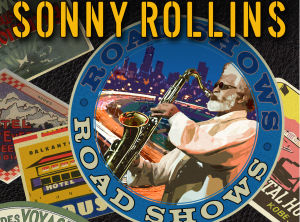
3.) Sonny Rollins, “Road Shows: Volume 3” (Okeh/Doxy)— I’m well aware that we who worship at the Altar of the Colossus often get carried away. My own effusions are tempered by what a fellow patron said about the GLTS (Greatest Living Tenor Saxophonist): that he’s a lot like Mickey Mantle because their strikeouts can be just as spectacular as their home runs. Still, you have to believe me when I tell you that this third installment of recent live Rollins feels richer, goes deeper and is altogether more rewarding than its predecessors. And I say this as somebody who tried, at first, to distract myself from its lure by doing…well I don’t remember exactly. But I do remember feeling my head swivel sharply upon hearing Rollins’ variations on “Someday I’ll Find You,” the album’s second track, from a 2006 performance in Toulouse. This Noel Coward ballad begs to be crooned in the grandest of tenor styles. Rollins never croons, at least not here. He asserts the theme while veering ever so modestly off its edges to let you know what’s coming as soon as he retrieves center stage from guitarist Bobby Broom. When it’s his turn to speak, Rollins slides into the first bars of the melody, pulling at its corners before he really gets to work somewhere around the third chorus. (Or is it the fourth? Never mind.) He’s clearing away open spaces for whatever direction he wants to go. At one point, he’s playing with the harmonies in the grand modernist manner of pulling them apart and rearranging them in different patters; maybe he’ll become fond of a riff and run with it to see if it opens still more territory, making just enough room for one of his licks to leap into the sky if only so he can find out where it lands. He’s trying to figure it all out as hard as we are. That’s why we’ve borne witness all these years: To collaborate in his process and share his potential surprise with what’s disclosed. There’s plenty more enlightenment to be found on these arias. And, jumping back a couple metaphors, there’s not a strikeout in the bunch.

4.) Kenny Barron & Dave Holland, “The Art of Conversation” (Blue Note) – Barron has proven to be such a compelling partner in previous recorded colloquies with Stan Getz, Charlie Haden and Regina Carter that it’s a wonder it’s taken this long for him to have a sustained sit-down with the indefatigable Mr. H. To say their meeting doesn’t disappoint would be understating matters to a felonious degree. They engage in an organic, mutually respectful flow of ideas and storylines with each man giving leeway to the other seemingly by intuition more than design. They hit all the lights on such standards as Parker’s “Segment” (which, for this occasion, should have worn its alternate title, “Diversity”), Monk’s “In Walked Bud” and, especially, Strayhorn’s “Daydream.” The revelations are more pronounced when it comes to each player’s compositions: Barron’s “Rain” opens vistas of lyrical expression for Holland while the latter’s “Dr. Do Right” craftily indulges Barron’s affinity for the Latin beat. I’m especially partial to the opening track, Holland’s “The Oracle,” because it is so reminiscent of one of my all-time favorite trio albums of the same name led by the late great Hank Jones and featuring Holland and the also-now-departed Billy Higgins. That album is out of print. This one more than compensates for its absence.

5.) Marc Ribot Trio, “Live at the Village Vanguard” (PI) – I have for decades challenged those who love hard rock, but hate progressive jazz to imagine, when listening to an outer-limits tenor sax solo, that there’s an electric guitar laying down the same pipe. I’ve urged jazz heads to do the reverse for heavy-metal speed runs. No takers at either end. But who’s going to listen to me anyway? Better that they should all listen to this, because when guitarist Ribot, drummer Chad Taylor and bassist Henry Grimes Go Outside as did John Coltrane (“Dearly Beloved,” “Sun Ship”) and Albert Ayler (“The Wizard,” “Bells”), they don’t merely make my point. They drive it home like a high-performance car going down on a steep hill at top speed. This unit’s been mining such territory for some time now and the revelations burn hotter within the hallowed confines of jazz’s Holy Dive. Oddly enough, though, it’s when Ribot and company do a 180 and apply their eclectic chops to light-footed, more conventional renditions of “Old Man River” and “I’m Confessin’ (That I Love You)” that they really seem to be taking chances; each man carefully spreading their range onto these chestnuts without unnecessary spillage. Their solicitousness within the body of each song gives greater magnitude to what they do outside the lines. Just to re-emphasize: Anything that’s done to amplify the enigmatic, yet persevering legacy of Grimes’ old boss Albert Ayler is worth the investment of energy; theirs, and yours.

6.) David Weiss, “When Words Fail” (Motema) – Most of the music here is so buoyant and luminous that you would never guess that the project is haunted by sadness and loss. Trumpeter Weiss, whose myriad activities include leadership of The Cookers, a septet formed in tribute to Freddie Hubbard, composed most of the pieces on this disc and writes in the liner notes of a full year of sudden, deepening tragedy beginning with the death of seven-year-old Ana Grace Marquez Greene, daughter of saxophonist Jimmy Greene, in the December, 2012 Sandy Hook School massacre. The father of the Motema label’s founder passed away during the ensuing year as did such jazz luminaries as Jim Hall, Donald Byrd, Mulgrew Miller, Butch Morris, George Duke and Cedar Walton. And just weeks after this session was completed, its bassist Dwayne Burro, died from pneumonia. The title track, named for the beginning of a Hans Christian Anderson quote that ends with “music speaks,” is dedicated to Burro while “Passage Into Eternity” was written with the Greene family in mind.. Here and elsewhere, you expect something somber and funereal, but instead find lively, propulsive small-group jazz that gives off warmth while staying resolutely cool. When the world keeps saying, “No,” music as joyfully rendered as this insists on saying, “Yes.”
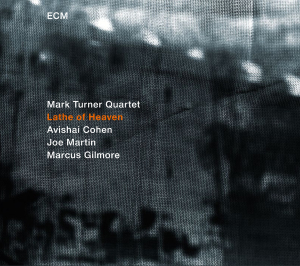
7.) Mark Turner Quartet, “Lathe of Heaven” (ECM)— Somewhere in the alchemic Ursula K. Le Guin novel that gives this disc its title, there’s a quote from Victor Hugo that describes dreaming as “nothing other than the approach of an invisible reality.” As with the book, much of the music on this album, Turner’s first as a leader in 13 years, shifts time and space while somehow remaining self-contained and grounded. Not since the passing of Joe Henderson has there been a narrative artist on tenor saxophone such as Turner, who, as with Henderson, makes his statements through stealth, cunning and patience, his phrases cohering into shapes that are at once familiar and esoteric. He finds in trumpeter Avishai Cohen a worthy harmonic partner in thematic expression; Cohen bringing a fiery, full-bodied tone to compliment Turner’s cool, dry musings. The overall pace seems locked in neutral, the better to allow the mercurial front line to simulate invisible realities, though the rhythm section of bassist Joe Martin and, especially, drummer Marcus Gilmore execute throughout a slipstream swing compatible with weaving dreams. You couldn’t call this a comeback since Turner’s been quite busy in many venues and combos. But having him return out front, so to speak, affirms the hopes he inspired a decade-and-a-half ago as a tenor player skating to a softer drumbeat.

8.) Steve Lehman Octet, “Mise en Abime” (PI) – Though not packaged as such, Lehman’s latest series of experiments in sound mosaics represents a kind of deep-space 90th birthday party for Bud Powell, given that at least two of the tormented bop genius’s pieces, “Glass Enclosure” and “Parisian Thoroughfare,” are so drastically reinvented as to be barely recognizable, except for the angular dynamics Lehman applies to their abstract designs. Because his intellectual qualifications are part of Lehman’s hype, you’re tempted to think of his work as composer, arranger and altoist in purely cerebral terms. But given his all-star lineup of some of the brightest young players (trumpeter Jonathan Finlayson, trombonist Tim Albright, saxophonist Mark Shim vibraphonist Chris Dingman and drummer Tyshawn Sorey among others), Lehman has too much firepower at his disposal to leave listeners on ice, so to speak. He’s so creative in his harmonic combinations and electronic enhancements that I’m a little curious to see what he does in more specified contexts; Christmas, say, or 1940s rhythm-and-blues, or the Sun Ra Songbook.

9.) Matt Wilson Quartet with John Medeski, “Gathering Call” (Palmetto) – I’ll just repeat what I posted back in January since a whole lot’s happened since then: Hard bop, late-1960s/early 1970s vintage, played without apologies and with an open-hearted joie de vivre that can make even the hardest of hard-core progressives wonder why they ever thought the genre was old news. I suppose some would still think it old news, even if they liked it. But there’s nothing musty or creaky about Wilson’s easygoing command of the trap set in all situations or his group’s saucy renditions of such Ellingtonia as “Main Stem” or “You Dirty Dog.” The quartet also pays homage to the recently departed bassist Butch Warren by playing the latter’s “Barack Obama” with the delicacy, wonder and cautious optimism you suspect the composer had in mind as he wrote it. You’re happy for the leader, one of the perennial Good Guys in the jazz business, which in turn makes you hopeful for the business itself.
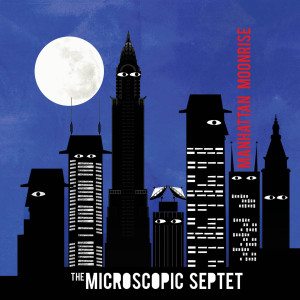
10.) The Microscopic Septet, “Manhattan Moonrise”(Cuneiform) — Where in their 1980s flowering they suggested, as a perspicacious observer put it, a “wedding band from Mars,” these wily retro sharpies now look on the inside-cover photos of this disc like a weathered, motley council of wizards from a Tolkien homage hiding out from Sauron on a band bus touring the Dakotas in the winter of 1939. Yet even with added snow in some of their membership’s facial hair, the Micros still sound airtight, agile and ready for anything co-founders Joel Forrester and Philip Johnston toss into their playpen, whether it’s a funk stomp a la Johnston’s “Obeying the Chemicals,” a Monk-ish pastiche from Forrester, “A Snapshot of the Soul” or the snap-brim eminently danceable swinger, also from Forrester, that gives the disc its title. Cards on the table, I’m at a loss to explain what “MM” by TMS is doing here since it doesn’t exactly break new ground either for the group or for its genre. But it’s a genre that they, and they alone, own: Microscopic Septet music at its most proficient, inquisitive and enjoyable. There may have been more significant and ambitious albums I heard or missed out on this year, but few that had as much trouble staying out of my machines as this. Long Live The Micros! And Long Live Jazz – whatever the heck that means!

HONORABLE MENTION: “Frank Kimbrough Quartet” (Palmetto); Tyshawn Sorey, “Alloy” (PI); Regina Carter, “Southern Comfort” (Masterworks ); Omer Avital, “New Song” (Motema); Ron Miles, “Circuit Rider” (Enja); Keith Jarrett & Charlie Haden, “Last Dance” (ECM); Randy Ingram, “Sky/Lift” (Sunnyside); Jason Jackson, “Inspiration” (Jack & Hill); Matthew Shipp, “I’ve Been To Many Places” (Thirsty Ear); Richard Galliano, “Sentimentale” (Resonance); Aaron Goldberg, “The Now” (Sunnyside).
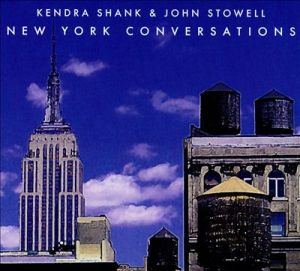
BEST VOCAL ALBUM: Kendra Shank and John Stowell, “New York Conversations” (TCB)
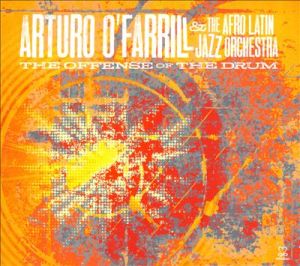
BEST LATIN ALBUM: Arturo O’Farrill & the Afro-Latin Jazz
Orchestra, “The Offense of the Drum” (Motema)

BEST REISSUE: John Coltrane, “Offering: Live at Temple University” (Impulse!)
HONORABLE MENTION: Charles Lloyd, “Manhattan Stories” (Resonance)
December 6th, 2013 — jazz reviews
Of the assorted cans of worms pried open among jazz heads on the Internet in recent years, my favorite comes from Branford Marsalis who has been calling out his peers (and, by implication, critics like me) for embracing virtuosity and harmonic invention at the expense of melodic content, which in turn was pushing more and more listeners away. “Harmonic music,” Marsalis said back in 2011, “tends to be very insular. It tends to be [like] you’re in the private club with a secret handshake.”
From that same interview: “When laypeople listen to records, there’re certain things they’re going to get to. First of all, how it sounds to them. If the value of the song is based on intense analysis of music, you’re doomed. Because people that buy records don’t know shit about music. When they put on ‘Kind of Blue’ and say they like it, I always ask people: What did you like about it? They describe it in physical terms, in visceral terms, but never in musical terms.”
The argument over whether jazz is hermetically sealing itself by being absorbed with invention-for-its-own-sake is as almost as old as jazz itself. Ralph Ellison and Albert Murray, for all their worship of literary modernism, snarled over most of the boundary-busting jazz music that came after the swing era. (People of varied generations and races are always shocked to find that Ellison disliked Charlie Parker almost as much as Philip Larkin.) Even Miles Davis at some point in the early1960s admitted that he didn’t buy jazz records of his era because “they make me too sad, man.”
I don’t get sad with what I hear lately. Once in a while, I even like being sad, and so do what Marsalis calls, “laypeople.” But there were times in the last several months when I was getting impatient with the new discs I was listening to. I was, like, OK, I’m impressed. But I’m not aroused. So you can make chord changes sit up, roll over and swim across a pond. But my question is the same one Lester Young asked long ago, “Can you sing a song?” I’ll throw another one out there: Can you handle a groove?
Maybe that’s why, even in a better-than-average year for product, I was drawn to those albums that gave me a bit more of what Marsalis describes as “physical” or “visceral” pleasure. I admit that in Larkin’s famous tautology, I still lean a little more towards intelligence-without-beat over beat-without-intelligence. But most of what I choose to venerate this year came close to achieving a balance between the two. The needle’s still stuck at the low end as far as jazz music’s presence in the marketplace is concerned. But maybe some of these will help nudge it a little higher and attract more people who search the clouds, or Cloud, for sounds that both please and challenge. Baby steps, I suppose; dance steps, I hope.

1.) Ahmad Jamal, “Saturday Morning” (Jazzbook) – You’re Ahmad Jamal and life right now couldn’t be more satisfying. You’ve outlasted almost all the pianists you’ve influenced since the 1950s who, fairly or not, received more critical approbation than you. You’ve also outlasted most of those critics who either demeaned or second-guessed your popularity and, in any case, never gave you the degree of respect you’ve received from audiences and fellow musicians. In the meantime, you’ve been putting out immaculately crafted recorded product for at least the last three decades. And at 83 years old, you’re playing with even greater vitality, invention and polish, submitting (for our approval) one of the crown jewels of your long career: A sweet-swinging session recorded at the Studio La Buissonne with the attentive support of bassist Reginald Veal and drummer Herlin Riley. As always, your trio keeps time like a handcrafted wristwatch. What broadens the package is the sparkling variety of tempo and mode. You seem even more engaged by the material, even with such familiar should-have-been-classics-long-ago as “The Line.” And though yours is the last such unit that would need extra percussion, the contributions of Manolo Badrena are seamlessly wired into your rhythm machine. You’re Ahmad Jamal and we’re just about as satisfied with your life right now as you are. (Thank you, Jimmy Cannon and may your own termite artistry soon be rediscovered.)

2.) Steve Coleman & Five Elements, “Functional Arrhythmias” (Pi) –And speaking of rhythm machines…First, though, a confession: Over the three or four decades alto saxophonist/composer Steve Coleman’s M-Base movement has been around, I could never cozy up to it; especially when it seemed intent on fashioning a kind of cerebral funk, as I prefer my funk to be pure and uncut. GIVE IT UP, PEOPLE, FOR BOOTSY’S RUBBER BAAAAAANNNND!!!! But I digress…If Coleman’s aesthetic principles have led to this ultra-sophisticated and fearsomely versatile aggregation of bassist Anthony Tidd, drummer Sean Rickman, guitarist Miles Okazaki and trumpeter Jonathan Finlayson, then I need to rethink, if not revoke, my earlier skepticism. As the titles of both the disc and its contents (e.g. “Sinews”, “Cerebrum Crossover”, “Cardiovascular”) imply, the intent here is to strike a polyrhythmic, harmonically complex connection with human physiology. It’s a smart idea (inspired, as Coleman says, by the example of drummer Milford Graves). But the intelligence behind the concept isn’t as conspicuous as its vigorous application. The band members are locked into each other’s frequencies and their interaction glides, strides, twists and meshes in the same manner as an abstract painting or modern dance piece. Coleman and Finlayson’s front-line conversations have a riveting yin-yang quality that places them at or near the high-end spectrum of such similar sax-horn confabs as Bird and Diz, Trane and Miles and Coleman’s namesake (if not relative) Ornette and Don Cherry. This disc has all the brains, and then some, of Coleman’s body-of-work. But it’s also got an unexpected surplus of — well, you know – heart.
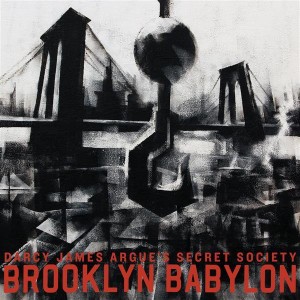
3.) Darcy James Argue’s Secret Society, “Brooklyn Babylon” (New Amsterdam) – Having spent twenty thrilling years inhabiting the Beautiful Borough as it made the awkward, irrepressible leap from hipster incubator to Promised Land, I can testify that one of the many things that fascinate even the most casual Brooklyn bystander is the ongoing tension between its gilded skyscraping aspirations and its wait-till-next-year past lives. This 17-part suite for an 18-piece orchestra conflates Brooklyn’s past, present and (potential) future into what amounts to a steampunk fantasy novel of the mind. Argue’s epic tells the story of a master carpenter named Lev who, in a dystopian future (or alternate present), is commissioned to build a carousel atop a tower whose immensity could obliterate whatever‘s left of Brooklyn’s old-soul romance. The music aims as high as that mythical tower and you can feel yourself ascending on its surging waves of energy. But the suite doesn’t just go up; it spreads out to encompass different cultures from Eastern Europe to Latin America to the Middle East, keeping a fingertip or two on all-American swing and/or rock. You could follow Argue’s story or project one of your own upon its volatile contours. As with the only science fiction that matters, “Brooklyn Babylon” is lavishly hypothetical, strangely familiar and recognizably human in the grandest and grubbiest terms.
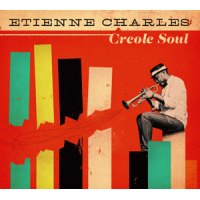
4.) Etienne Charles, “Creole Soul” (Culture Shock) – Jazz’s grow-or-die imperative has found its most gratifying adherents among 30-and-under musicians willing to use what they’ve learned of the music’s basics as springboards to more adventurous or exotic compounds. Charles, who just turned 30 this year, is a Trinidad-born trumpeter who received much of his education at Florida State and Juilliard and was inspired by the examples set at both institutions respectively by Marcus Roberts and Wynton Marsalis in re-energizing the music’s mainstream traditions. He retains some of Marsalis’ sound in his horn. But it’s the multicultural, polyrhythmic setting of this zesty, spicy gumbo that makes Charles’ music sound like exactly no one else’s. With a formidable array of young instrumentalists and percussionists as backup, Charles immerses himself in the varied strains of Caribbean pop – reggae, mambo, conga, even Gulf Coast R&B – to put together an mélange of electro-boogie, calypso and funk. Traditionalists can growl, snap and dismiss it all as “slick” pop. But the music they cherish has a far better chance for long-term survival with a sensibility willing to invite Monk (“Green Chimneys”), Marley (“Turn Your Lights Down Low”) and Bo Diddley (“You Don’t Love Me”) to the same house party and give each of them the respect and elbowroom they deserve. And, by the way, he also serves up melodies that stick to your head like Post-It notes reminding you what music is for.
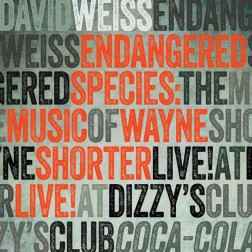
5.) David Weiss, “Endangered Species: The Music of Wayne Shorter” (Motema) –Weiss, who also holds down a trumpeter’s chair here, leads a 12-piece murderer’s row of first-rank instrumentalists that includes trombonist Steve Davis, trumpeter Jeremy Pelt, saxophonists Ravi Coltrane and Tim Green, drummer E.J. Strickland and the incomparable pianist Geri Allen in celebrating the legacy and (though recorded live a year earlier at Dizzy’s Club Coca-Cola) 80th birthday of the Greatest Living Jazz Composer. They do not come to merely pay homage. That would be too much like church and the guy they’re honoring is far from finished. (See below.) Weiss instead leads his cadre on a reconnaissance mission probing the less-heralded (as in least-covered) pieces of the Shorter oeuvre as a means of illuminating its orchestral possibilities. The recital opens your eyes from the jump with “Nellie Bly,” which the always-surprising Mr. Weird wrote very early in his career when he was sitting in Maynard Ferguson’s reed section and now comes across as one of the more ornately conceived barn-burners ever lit. Even the most familiar of these selections, the inscrutably haunting ballad “Fall,” is given a rich, harmonically-layered treatment that inspires glistening fire-and-ice variations from Allen, Coltrane and, especially, Pelt. As widely acknowledged as Shorter’s writing brilliance has been over generations, it takes a classic setting such as this to reaffirm both the sturdiness and suppleness of Shorter’s melodies e.g., they endure and you can do almost anything you want with them.
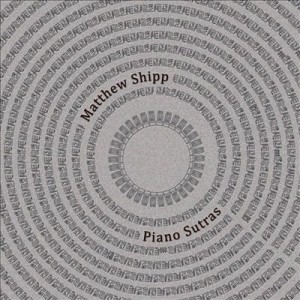
6.) Matthew Shipp, “Piano Sutras” (Thirsty Ear) – If progressive jazz pianists carried the same renegade credibility in pop culture as heavy-metal rock guitarists, Matthew Shipp would be a biker’s tattoo by now. Twenty-something years is a long time to be an Angry Young Man. But the customary rules don’t apply to Shipp, who at age 53 can still wield a thorny club with swaggering panache, both on- and off-stage. His jazz-outlaw persona packs dual reserves of intensity and insolence; the latter, especially, gets him noticed in jazz circles when it’s directed at such elder statesmen as Shorter, Herbie Hancock and Keith Jarrett – the latter of whom could, ironically enough, match Shipp on whatever Mr. Cranky meter that’s available. For whatever it’s worth, I think Shipp’s uncompromising, mostly unsung insurgency gives him better reason to complain than Jarrett. He even released a “Greatest Hits” compilation earlier this year that made an impassioned what-the-eff-more-do-I-have-to-do case for his artistry. Still, this solo recital, meditative, prickly and ingenious, is an even more persuasive brief on Shipp’s behalf. It literally stomps, like the step-master of an unruly fraternity, to its own beat, piling dense tone clusters and weaving thick harmonic passages into eccentric, arresting patterns. On such pieces as “Cosmic Shuffle” and “Uncreated Light,” Shipp indulges his combative impulses before giving way to lyrical rumination. Though he may seem at times to be an unrepentant churl, Shipp’s “Sutras” remind listeners that, whatever hard things he may have to say, or play, at a given moment, he’s not inclined to stay mad – or stay anything else – for very long. (I bet he’s still happy, though, that I ranked this disc ahead of the next one.)

7.) Wayne Shorter Quintet, “Without a Net” (Blue Note) –As I said (maybe) earlier this year, the more I’ve listen to it, the deeper its mysteries grow; almost to the point of making me wonder whether there’s anything more to this group’s colloquies than mysteries for their own sake. Then, I try to tell myself what Shorter, in his way, is telling everybody else: that questions and answers are often the same thing. And I’ll go, yes, but…This incessant give-and-take between my ears is why “Without a Net,” for all its insistence on keeping secrets, stays on this list, no matter what. Give me another month or two and it’ll likely be back in the top five, but for the moment….
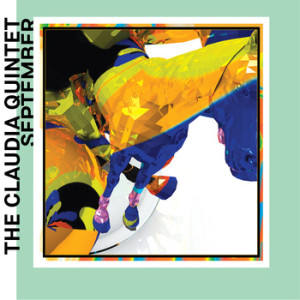
8.) The Claudia Quintet, “September” (Cuneiform) – Because I am an easy mark for crafty historical gimmicks, I was piped aboard this vessel by a number called “September 29th, 1936: ‘Me Warn You’,” in which the voice of FDR, sarcastically chiding his Republican fat-cat opposition for their empty promises of out-dealing the New Deal, is carved up, sampled, mixed, mimicked and harmonized with throughout by this eclectic chamber ensemble led by percussionist John Hollenbeck and featuring Chris Speed on reeds, Matt Moran on vibes, Red Wierenga on accordion and either Drew Gress or Chris Tordini on bass. Once you get past the wonder of hearing instrumental correlatives to Roosevelt’s memorable pipes and recognize the sly contemporary references being made by this juxtaposition, you start to wonder if the joke is being carried a little too far – until, about seven minutes in, when the group, collectively and individually, starts laying down its own cheeky variations on the president’s joke. This open-ended interplay typifies the rest of the album – a series of sound mosaics and tone poems devoted to the month that Hollenbeck prefers to use as time for reflection and contemplation. There’s a witty birthday salute to the unavoidable Mr. Shorter (“September 9th Wayne Phases”), a deep-dyed autumnal ballad (“September 25th Somber Blanket”) and, inevitably, a 9/11 piece (“September 12th Coping Song”) that closes the disc on with introspection that never becomes maudlin. It’s taken me longer than it probably should to have climbed aboard Claudia’s bandwagon and I’m still not sure why this particular one did the trick. But I plan to check back with them.
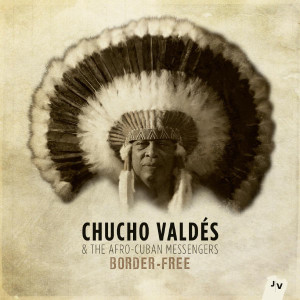
9.) Chucho Valdes, “Border Free” (Jazz Village) – I hope he wont take this the wrong way, but it must be said up-front: This man is a beast, a monster, an unstoppable force-of-nature – and, to be sure, a supreme virtuoso. But his is the kind of virtuosity that, rather than swooping down from thin air, blows the doors open to his listeners, making them run en masse towards him and scream for more. (Just listen to the first five minutes of “Congadanza” and you’ll know exactly what I mean. The last four are pretty “wow”, too.) Valdes is also a paragon among 70-something artists who seem to be gaining in raw power and messianic force with age. He and his Afro-Cuban Jazz Messengers aren’t just wearing down the all-but-fragmented barriers between hard bop and Latin jazz; they’re also expanding rhythmic horizons towards Native American (“Afro-Comanche”) and Andalusian (“Abdel”) sources of inspiration. He also takes time out to honor both his pianist father (“Bebo”) and his late mother (“Pilar”) in ways that make his Cuban homeland vivid and stirring. OK, so he gets a little carried away at times with the occasional Rachmaninoff reference and melodramatic flourish. So long as you can still keep up with the stories, what do they matter?
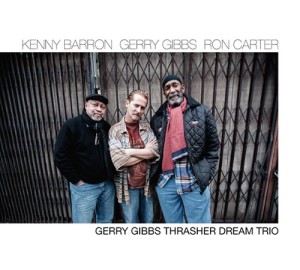
10.) Gerry Gibbs, Kenny Barron, Ron Carter, “Gerry Gibbs Thrasher Dream Trio” (Whaling City Sound) – If I had Barron, a grandmaster of jazz piano, and Carter, the greatest bassist alive, at my disposal, I bet even I could complete a dream trio with a frying pan, a crockpot and a pair of wooden spoons. But Gibbs, who’s been following in his vibraphonist father Terry’s footsteps by leading his own big band, brings his own aggressive sound, far-reaching chops and orchestrator’s instincts to this session, giving these two demigods a wide-open frame for their immense resources to roam like wolves. The result is a surprising rarity: a piano trio album delivering music with the heft and momentum of a larger ensemble, thanks mostly to the prodigious balance of power and flexibility coming through Gibbs’ trap set. Along with the usual stops (“Epistrophy,” “Impressions,”), the trio shines new light on works by McCoy Tyner (“When I Dream”) and Herbie Hancock (“The Eye of the Hurricane,” “Tell Me a Bedtime Story”). The biggest revelations, however, come from the pop book: that old mid-1960s warhorse, “The Shadow of Your Smile,” Stevie Wonder’s “Don’t You Worry ‘Bout a Thing” and, most especially “Promises, Promises,” whose sleek mounting and seamless arrangement here showcase Carter and Barron’s mastery of tempo and changes while delivering what may be the most effective jazz take yet on a Burt Bacharach tune.
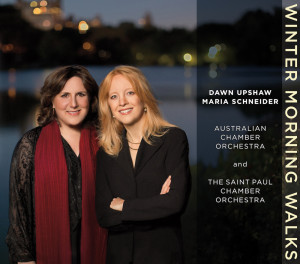
HONORABLE MENTION: Maria Schneider & Dawn Upshaw, “Winter Morning Walks” (ArtistShare) Marc Cary, “For the Love of Abbey” (Motema) Charles Lloyd & Jason Moran, “Hagar’s Song” (ECM) Joe Lovano UsFive, “Cross Culture” (Blue Note) Geri Allen, “Grand River Crossings” (Motema) Bill Frisell, “Big Sur” (Okeh) Carla Bley, Andy Sheppard, Steve Swallow, “Trios” (ECM) Wadada Leo Smith & Tumo, “Occupy the World” (Tum) Ben Allison, “The Stars Look Very Different Today” (Sonic Camera) Rudresh Mahanthappa, “Gamak” (ACT) Fred Hersch & Julian Lage, “Free Flying” (Palmetto) Art Pepper, “Unreleased Art, Vol. VIII: Live at the Winery, September 6, 1976” (Widow’s Taste) Matt Mitchell, “Fiction” (Pi)
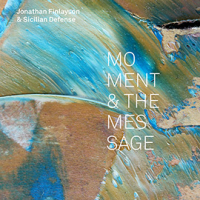
BEST NEW ARTIST: Jonathan Finlayson & Sicilian Defense, “Moment & the Message” (Pi)
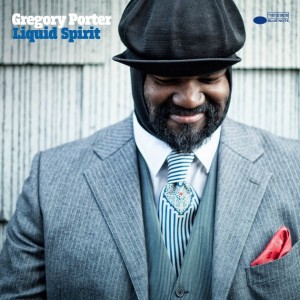
BEST VOCALIST: Gregory Porter, “Liquid Spirit” (Blue Note) HONORABLE MENTION: Youn Sun Nah, “Lento” (ACT)
BEST LATIN ALBUM: “Creole Soul” HONORABLE MENTION: “Border-Free”








































